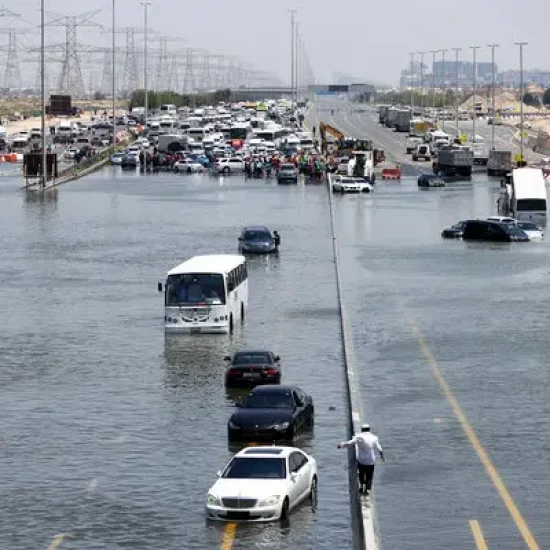Humans will be extinct in 100 years because the planet will be uninhabitable, according to Australian microbiologist Frank Fenner, one of the leaders of the effort to eradicate smallpox in the 1970s. He blames overcrowding, denuded resources and climate change.
Fenner’s prediction is not a sure bet, but he is correct that there is no way emissions reductions will be enough to save us from our trend toward doom. And there doesn’t seem to be any big global rush to reduce emissions, anyway. When the G7 called on Monday for all countries to reduce carbon emissions to zero in the next 85 years, the scientific reaction was unanimous: That’s far too late.
And no possible treaty that emerges from the current United Nations Framework Convention on Climate Change in Bonn, Germany, in preparation for November’s United Nations climate conference in Paris, will be sufficient. At this point, lowering emissions is just half the story — the easy half. The harder half will be an aggressive effort to find the technologies needed to reverse the climate apocalypse that has already begun.
For years now, we have heard that we are at a tipping point. Al Gore warned us in An Inconvenient Truth that immediate action was required if we were to prevent global warming. In 2007, Sir David King, former chief scientific advisor to the British government, declared, “Avoiding dangerous climate change is impossible – dangerous climate change is already here. The question is, can we avoid catastrophic climate change?” In the years since, emissions have risen, as have global temperatures. Only two conclusions can be drawn: Either these old warnings were alarmist, or we are already in far bigger trouble than the U.N. claims. Unfortunately, the latter seems to be the case.
Lowering emissions and moving to cleaner energy sources is a necessary step to prevent catastrophic temperature rises. The general target is to keep global temperatures from rising more than 2 degrees Celsius. Higher increases — like the 5C increase currently projected by 2100 — run the risk of widespread flooding, famine, drought, sea-level rise, mass extinction and, worse, the potential of passing a tipping point (frequently set at 6C) that could render much of the planet uninhabitable and wipe out most species. Even the 2C figure predicts more than a meter’s rise in sea levels by 2100, enough to displace millions. It is no wonder that the Pentagon calls climate change a serious “threat multiplier” and is considering its potential disruptive impact across all its planning.
This is where the U.N. talks fall short — by a mile. The targets proffered by the United States (a 26 percent to 28 percent decrease from 2005 levels by 2025), the European Union (a 40 percent decrease from 1990 levels by 2030) and China (an unspecified emissions peak by 2030) are nowhere near enough to keep us under the 2C target. In 2012, journalist Bill McKibben, in a feature for Rolling Stone, explained much of the math behind the current thinking on global warming. He concluded that the United Nations’ figures were definitely on the rosy side. In particular, McKibben noted that the temperature has already increased 0.8C, and even if we were to stop all carbon-dioxide emissions today, it would increase another 0.8C simply due to the existing carbon dioxide in the atmosphere. That leaves only a 0.4C buffer before hitting 2C. Even assuming the Paris conference implements everything that’s promised, we will be on track to use up the remaining “carbon budget” — the amount of carbon we can emit without blowing past the 2C threshold — within two to three decades, not even at mid-century.
These emissions-reduction frameworks, it is safe to say, are simply insufficient. By themselves, they only offer a small chance of preventing the earth from becoming mostly uninhabitable – for humans at least — over the next few centuries. For the talks to be more than just a placebo, they need to encompass aggressive plans for climate mitigation, with the assumption that current wishful targets won’t be met.
Apart from coordination to cope with climate-driven crises and associated instability, climate-change leadership needs to encourage and fund the development of technologies to reverse what we are unable to stop doing to our planet. Many of these technologies fall under the rubric of “carbon sequestration” — safely storing carbon rather than emitting it. Riskier strategies, like injecting sulfates into the air to reflect more of the sun’s heat into space and ocean iron fertilization to grow algae to suck in carbon, run a high risk of unintended consequences. Better and safer solutions to reduce CO2 concentrations in the atmosphere don’t yet exist; we need to discover them and regulate them, to avoid the chaos of what economists Gernot Wagner and Martin L. Weitzman term “rogue geoengineering” in their book Climate Shock.
None of these approaches are substitutes for emissions reductions. Achieving a carbon-neutral society is a necessary long-term goal regardless of other technological fixes. Technology could buy us the time to get there without our planet burning up. Ultimately, we need a Cold War-level of investment in research into new technologies to mitigate the coming effects of global warming. Without it, the U.N.’s work is a nice gesture, but hardly a meaningful one.



![dubai flood is artificial rain behind uaes rare torrential weather[1]](https://thearabianpost.com/wp-content/uploads/2024/04/dubai-flood-is-artificial-rain-behind-uaes-rare-torrential-weather1-e1713378975696-550x550.jpg)


![2022 09 27T183330Z 84178340 RC2RJV9S1G6M RTRMADP 3 SAUDI POLITICS[1]](https://thearabianpost.com/wp-content/uploads/2024/04/2022-09-27T183330Z_84178340_RC2RJV9S1G6M_RTRMADP_3_SAUDI-POLITICS1-e1712223217759-550x550.jpg)

